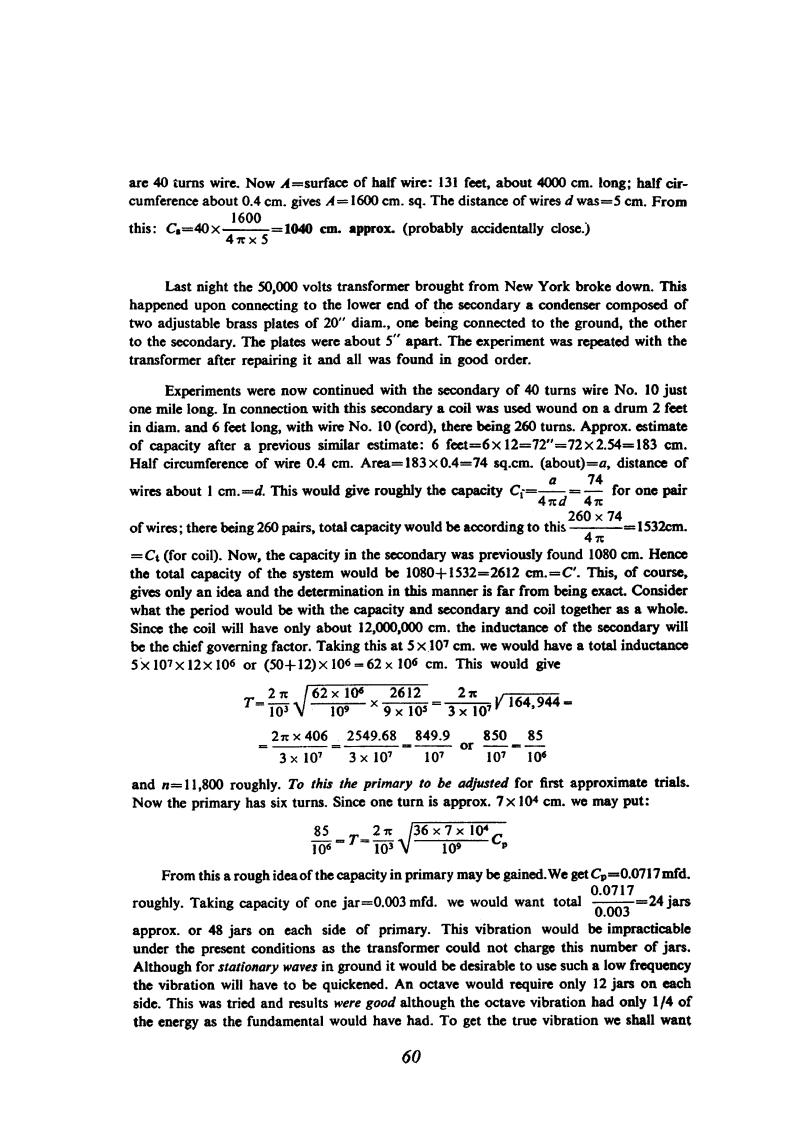
Nikola Tesla Books
are 40 turns wire. Now A=surface of half wire: 131 feet, about 4000 cm. long; half circumference about 0.4 cm. gives A=1600 cm. sq. The distance of wires d was=5 cm. From this: Cs = 40 x $! {1600 \over {4 \pi \times 5}} $! = 1040 cm. approx. (probably accidentally close.)
Last night the 50,000 volts transformer brought from New York broke down. This happened upon connecting to the lower end of the secondary a condenser composed of two adjustable brass plates of 20" diam., one being connected to the ground, the other to the secondary. The plates were about 5" apart. The experiment was repeated with the transformer after repairing it and all was found in good order.
Experiments were now continued with the secondary of 40 turns wire No. 10 just one mile long. In connection with this secondary a coil was used wound on a drum 2 feet in diam. and 6 feet long, with wire No. 10 (cord), there being 260 turns. Approx. estimate of capacity after a previous similar estimate: 6 feet = 6 x 12 = 72" = 72 x 2.54 = 183 cm. Half circumference of wire 0.4 cm. Area = 183 x 0.4 = 74 sq. cm. (about) = a, distance of wires about 1 cm. =d. This would give roughly the capacity C1 = $! {a \over {4 \pi d}} $! = $! {74 \over {4 \pi}} $! for one pair of wires; there being 260 pairs, total capacity would be according to this $! {{260 \times 74} \over {4 \pi}} $! = 1532cm. = Ct (for coil). Now, the capacity in the secondary was previously found 1080 cm. Hence the total capacity of the system would be 1080 + 1532 = 2612 cm. = Câ. This, of course, gives only an idea and the determination in this manner is far from being exact. Consider what the period would be with the capacity and secondary and coil together as a whole. Since the coil will have only about 12,000,000 cm. the inductance of the secondary will be the chief governing factor. Taking this at 5 x 107 cm. we would have a total inductance 5 x 107 x 12 x 106 or (50 + 12) x 106 = 62 x 106 cm. This would give
T = $! {{{2 \pi} \over 10^{3}} {\sqrt{{{62 \times 10^{6}} \over 10^{9}} \times {2612 \over {9 \times 10^{5}}}}}} $! = $! {{{2 \pi} \over {3 \times 10^{7}}} \sqrt{164,944}} $! =
= $! {{2 \pi \times 406} \over {3 \times 10^{7}}} $! = $! {2549.68 \over {3 \times 10^{7}}} $! = $! {849.9 \over 10^{7}} $! or $! {850 \over 10^{7}} $! = $! {85 \over 10^{6}} $!
and n = 11,800 roughly. To this the primary to be adjusted for first approximate trials. Now the primary has six turns. Since one turn is approx. 7 x 104 cm. we may put:
$! {85 \over 10^{6}} $! = T = $! {{2 \pi} \over 10^{3}} \sqrt{{{36 \times 7 \times 10^{4}} \over 10^{9}} C_{p}} $!
From this a rough idea of the capacity in primary may be gained. We get Cp = 0.0717mfd. roughly. Taking capacity of one jar = 0.003 mfd. we would want total $! {0.0717 \over 0.003} $! = 24 jars approx. or 48 jars on each side of primary. This vibration would be impracticable under the present conditions as the transformer could not charge this number of jars. Although for stationary waves in ground it would be desirable to use such a low frequency the vibration will have to be quickened. An octave would require only 12 jars on each side. This was tried and results were good although the octave vibration had only 1/4 of the energy as the fundamental would have had. To get the true vibration we shall want
60
July 3
Secondary distributed capacitance is one of the Tesla oscillator elements which cannot be determined easily. This magnitude depends on coil diameter, wire size and its insulation and coil winding method. At one layer coils it originates mainly due to influence of adjacent windings and Tesla calculates it so. He ultimately simplifies the model and takes that parasitic capacitance per turn is equal A/4Ïd, where A=rÏl - ½ of one turn wire area, and 'd' is distance between turns. According to this model, capacitance is calculated as for a plate type capacitor of area A and distanced between plates with air insulation. There are a number of disadvantages of such a model, but it should not be forgotten that Tesla is looking for the solution. It is not correct also that he considers in the secondary circuit with "additional coil" all inductances and capacitances added together, but Tesla is aware that all this is just guessing and he frequently mentions words as "approximately", "estimate" and "similar".
Contrary to one previous calculation (please see June 20) when Tesla started with primary circuit and calculated the secondary, now he does the opposite; on the basis of secondary circuit resonant frequency and known primary inductance (one turn) he determines the primary circuit capacitance. After that he checks whether the found capacitance is allowed to be used with regards to the transformer power of low frequency. The applied equation is approximate, but it is good for orientational analysis of network transformer energy balance. Maximum transformer power has to be larger than the found one, because the capacitor in the primary is not charged all the time, and then only in short impulses.

